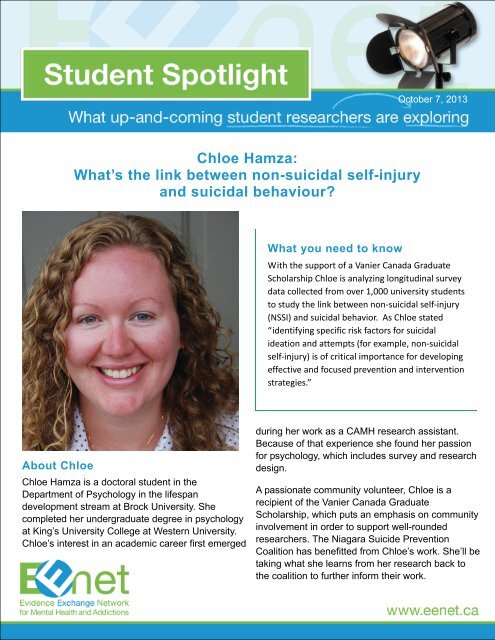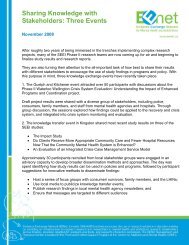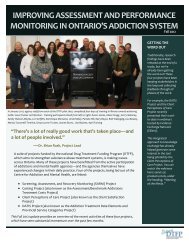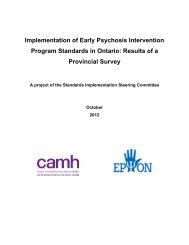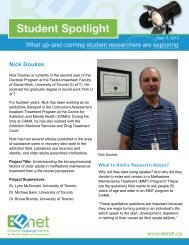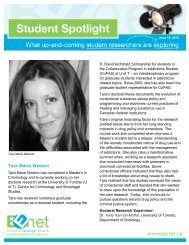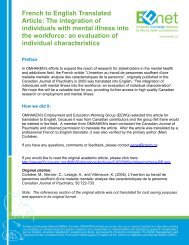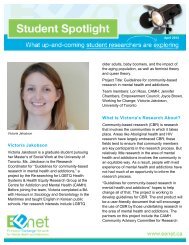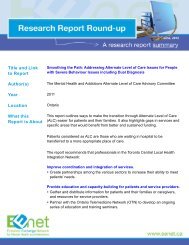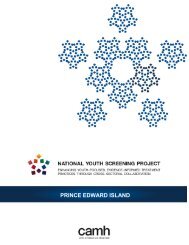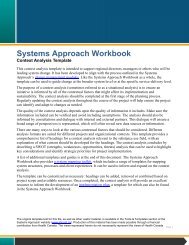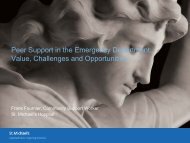Chloe Hamza: What's the link between non-suicidal self ... - EENet
Chloe Hamza: What's the link between non-suicidal self ... - EENet
Chloe Hamza: What's the link between non-suicidal self ... - EENet
Create successful ePaper yourself
Turn your PDF publications into a flip-book with our unique Google optimized e-Paper software.
October 7, 2013<br />
<strong>Chloe</strong> <strong>Hamza</strong>:<br />
What’s <strong>the</strong> <strong>link</strong> <strong>between</strong> <strong>non</strong>-<strong>suicidal</strong> <strong>self</strong>-injury<br />
and <strong>suicidal</strong> behaviour?<br />
What you need to know<br />
With <strong>the</strong> support of a Vanier Canada Graduate<br />
Scholarship <strong>Chloe</strong> is analyzing longitudinal survey<br />
data collected from over 1,000 university students<br />
to study <strong>the</strong> <strong>link</strong> <strong>between</strong> <strong>non</strong>‐<strong>suicidal</strong> <strong>self</strong>‐injury<br />
(NSSI) and <strong>suicidal</strong> behavior. As <strong>Chloe</strong> stated<br />
“identifying specific risk factors for <strong>suicidal</strong><br />
ideation and attempts (for example, <strong>non</strong>‐<strong>suicidal</strong><br />
<strong>self</strong>‐injury) is of critical importance for developing<br />
effective and focused prevention and intervention<br />
strategies.”<br />
About <strong>Chloe</strong><br />
<strong>Chloe</strong> <strong>Hamza</strong> is a doctoral student in <strong>the</strong><br />
Department of Psychology in <strong>the</strong> lifespan<br />
development stream at Brock University. She<br />
completed her undergraduate degree in psychology<br />
at King’s University College at Western University.<br />
<strong>Chloe</strong>’s interest in an academic career first emerged<br />
during her work as a CAMH research assistant.<br />
Because of that experience she found her passion<br />
for psychology, which includes survey and research<br />
design.<br />
A passionate community volunteer, <strong>Chloe</strong> is a<br />
recipient of <strong>the</strong> Vanier Canada Graduate<br />
Scholarship, which puts an emphasis on community<br />
involvement in order to support well-rounded<br />
researchers. The Niagara Suicide Prevention<br />
Coalition has benefitted from <strong>Chloe</strong>’s work. She’ll be<br />
taking what she learns from her research back to<br />
<strong>the</strong> coalition to fur<strong>the</strong>r inform <strong>the</strong>ir work.
Page 2 of 3<br />
<strong>Chloe</strong>’s o<strong>the</strong>r scholarships include <strong>the</strong> Joseph-<br />
Armand Bombardier Canada Graduate Scholarship,<br />
and <strong>the</strong> doctoral Ontario Graduate Scholarship.<br />
<strong>Chloe</strong>’s research has been published in a variety of<br />
academic journals, and she has presented at<br />
several conferences.<br />
What is <strong>Chloe</strong>’s Research About?<br />
As many as 13 to 38 per cent of undergraduate<br />
students have a lifetime history of <strong>non</strong>-<strong>suicidal</strong> <strong>self</strong>injury<br />
(NSSI). This behaviour is defined as <strong>self</strong>directed<br />
deliberate destruction or alteration of bodily<br />
tissue in <strong>the</strong> absence of <strong>suicidal</strong> intent–such as <strong>self</strong>cutting,<br />
carving, and burning. Although NSSI can be<br />
differentiated from <strong>suicidal</strong> behavior, emerging<br />
evidence shows that NSSI may lead to increased<br />
<strong>suicidal</strong> risk (<strong>Hamza</strong>, Stewart & Willoughby 2012).<br />
<strong>Chloe</strong> <strong>Hamza</strong>, a doctoral student in <strong>the</strong> Department<br />
of Psychology at Brock University, is looking at <strong>the</strong><br />
<strong>link</strong> <strong>between</strong> NSSI and <strong>suicidal</strong> behavior. Her work<br />
seeks to identify individuals with a history of NSSI<br />
who are most at risk for <strong>suicidal</strong> behavior. It also<br />
aims to understand <strong>the</strong> mechanism through which<br />
NSSI may increase an individual’s risk for <strong>suicidal</strong><br />
behavior.<br />
<strong>Chloe</strong> is analyzing longitudinal survey data collected<br />
from over 1,000 students at Brock University (4<br />
waves of data, each collected one year apart). At<br />
each wave, students completed <strong>self</strong>-injury<br />
inventories assessing NSSI and <strong>suicidal</strong> behaviors.<br />
<strong>Chloe</strong> is also exploring whe<strong>the</strong>r NSSI may lead to<br />
increased risk for <strong>suicidal</strong> behavior through<br />
increased tolerance to pain over time. Her premise<br />
is being examined through a subset of participants<br />
who have also taken part in a lab-based study.<br />
<strong>Chloe</strong> has built in some safety measures for <strong>the</strong><br />
participants completing <strong>the</strong> survey. Students are<br />
asked if <strong>the</strong>y want to be contacted if <strong>the</strong>y are<br />
feeling extreme stress in <strong>the</strong>ir lives and in general<br />
having trouble coping. If <strong>the</strong> answer is “yes”<br />
trained surveyors can provide mitigating strategies<br />
for <strong>the</strong>se students.<br />
Feedback from students indicates that in general<br />
<strong>the</strong>y appreciated filling out <strong>the</strong> one-hour survey.<br />
Some indicated that <strong>the</strong> experience was <strong>the</strong> first<br />
time <strong>the</strong>y had disclosed <strong>the</strong>ir NSSI behaviour.<br />
Students expressed that <strong>self</strong>-reflection is a very<br />
important part of <strong>the</strong> survey process.<br />
A newsletter entitled Stressed@Brock brings<br />
survey results and updates to those that<br />
participated in <strong>the</strong> research. Feedback from <strong>the</strong><br />
newsletter shows that participants seem to be<br />
anticipating <strong>the</strong> newsletters and <strong>the</strong> general<br />
results.<br />
How can this research be used?<br />
Little is known about <strong>the</strong> development and<br />
maintenance of <strong>suicidal</strong> behavior over time,” says<br />
<strong>Chloe</strong>. “But identifying specific risk factors for<br />
<strong>suicidal</strong> ideation and attempts (for example, <strong>non</strong><strong>suicidal</strong><br />
<strong>self</strong>-injury) is of critical importance for<br />
developing effective and focused prevention and<br />
intervention strategies.” <strong>Chloe</strong> hopes to publish her<br />
research findings in academic journals, and<br />
disseminate <strong>the</strong> findings at academic and clinical
Page 3 of 3<br />
conferences. She enjoys <strong>the</strong> community work as<br />
well and strives to have her work disseminated to<br />
larger audiences.<br />
“I hope that my research can serve to fur<strong>the</strong>r reveal<br />
<strong>the</strong> processes through which <strong>non</strong>-<strong>suicidal</strong> <strong>self</strong>-injury<br />
may increase risk for suicide, and assist clinicians in<br />
identifying those individuals most at risk for <strong>suicidal</strong><br />
behavior and create effective treatment<br />
approaches.”<br />
What is next for <strong>Chloe</strong>?<br />
<strong>Chloe</strong> hopes to obtain a post-doctoral research<br />
fellowship to continue her research on <strong>self</strong>-injury.<br />
Her long-term professional goal is to become an<br />
independent mental health researcher at an<br />
academic institution or research-based<br />
organization. She also plans to continue to make<br />
her work relevant for community agencies<br />
Selected journal articles that <strong>Chloe</strong><br />
has published<br />
Thamza, C., & Willoughby, T. (2013). Non<strong>suicidal</strong><br />
<strong>self</strong>-injury and <strong>suicidal</strong> behavior: A latent class<br />
analysis among young adults. PLOS ONE. doi:<br />
10.1371/journal.pone.0059955.<br />
Project Title: “Examining <strong>the</strong> Link <strong>between</strong><br />
Non-<strong>suicidal</strong> Self-injury and Suicidal<br />
Behaviour”<br />
Project Supervisors: Dr. Teena<br />
Willoughby, Brock University<br />
Doctoral Committee:<br />
Dr. Dorothy Markiewicz, Brock University<br />
Dr. Linda Rose-Krasnor, Brock University<br />
<strong>Hamza</strong>, C., Willoughby, T., & Good, M. (2013). A<br />
preliminary examination of <strong>the</strong> specificity of <strong>the</strong><br />
functions of <strong>non</strong><strong>suicidal</strong> <strong>self</strong>-injury among a sample<br />
of university students. Psychiatry Research, 205,<br />
172-175. doi: 10.1016/j.psychres.2012.08.036.<br />
<strong>Hamza</strong>, C., & Willoughby, T. (2013). A longitudinal<br />
person-centred examination of <strong>non</strong><strong>suicidal</strong> <strong>self</strong>injury<br />
among university students. Journal of Youth<br />
and Adolescence. doi:10.1007/s10964-013-9991-8.<br />
For more information about <strong>Chloe</strong>’s research,<br />
please contact her at ch08za@brocku.ca.<br />
Author: Bonnie Polych, M.Ed.<br />
Regional Knowledge Exchange Lead<br />
October 7, 2013


